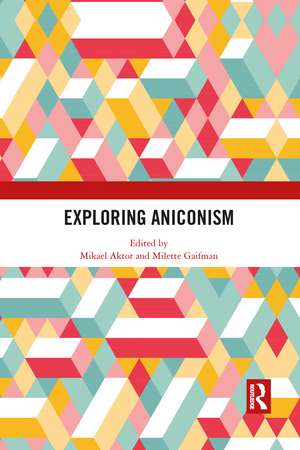Exploring Aniconism
Editat de Mikael Aktor, Milette Gaifmanen Limba Engleză Paperback – 30 iun 2021
The contributors show how various types of aniconism differ in how they mediate divine presence and relate to other modes of representation. Aniconism is rarely absolute; each aniconic form needs to be considered within a spectrum of visual modes ranging from the abstract to the anthropomorphic. The chapters examine aniconism in paleolithic cultures; in ancient Egypt, Israel, and Greece; in early Christianity and Islam; in medieval and contemporary Hinduism; and in 17th–19th century Scottish-Gaelic contexts. The volume also provides a critical historiography of ‘aniconism’ as an academic concept, a new fine-tuned terminology, and some general characteristics of aniconic expressions in the context of the broader field of material religion.
Offering a multi-faceted discussion of this important category of religious material culture, this book will be of interest to those with an interest in aniconism, as well as those involved in the wider study of how religion intersects with art and anthropology.
This book was originally published as a special issue of the Religion journal.
| Toate formatele și edițiile | Preț | Express |
|---|---|---|
| Paperback (1) | 384.09 lei 6-8 săpt. | |
| Taylor & Francis – 30 iun 2021 | 384.09 lei 6-8 săpt. | |
| Hardback (1) | 764.20 lei 6-8 săpt. | |
| Taylor & Francis – 12 noi 2019 | 764.20 lei 6-8 săpt. |
Preț: 384.09 lei
Nou
Puncte Express: 576
Preț estimativ în valută:
73.50€ • 78.59$ • 61.28£
73.50€ • 78.59$ • 61.28£
Carte tipărită la comandă
Livrare economică 18 aprilie-02 mai
Preluare comenzi: 021 569.72.76
Specificații
ISBN-13: 9781032085920
ISBN-10: 1032085924
Pagini: 180
Dimensiuni: 174 x 246 x 10 mm
Greutate: 0.3 kg
Ediția:1
Editura: Taylor & Francis
Colecția Routledge
Locul publicării:Oxford, United Kingdom
ISBN-10: 1032085924
Pagini: 180
Dimensiuni: 174 x 246 x 10 mm
Greutate: 0.3 kg
Ediția:1
Editura: Taylor & Francis
Colecția Routledge
Locul publicării:Oxford, United Kingdom
Public țintă
Postgraduate and UndergraduateCuprins
1. Aniconism: definitions, examples and comparative perspectives 2. Aniconism and the origins of palaeoart 3. The real presence of Osiris: iconic, semi-iconic and aniconic ritual representations of an Egyptian god 4. Aniconic propaganda in the Hebrew Bible, or: the possible birth of religious seriousness 5. Aniconism in the first centuries of Christianity 6. The royal veil: early Islamic figural art and the Bilderverbot reconsidered 7. Stone-agency: sense, sight and magical efficacy in traditions of the Highlands and Islands of Scotland 8. Śiva’s multiplicity of presence in aniconic and iconic form 9. Drawing out the iconic in the aniconic: worship of neem trees and Govardhan stones in Northern India 10. The Hindu pañcāyatanapūjā in the aniconism spectrum
Notă biografică
Mikael Aktor is an Associate Professor in Studies of Religions at the University of Southern Denmark, Odense, Denmark. His publications include Object of Worship in South Asian Religions (with Knuth Jacobsen and Kristina Myrvold, 2015). His other research area is the study of ancient and medieval Hindu law.
Milette Gaifman is an Associate Professor in Classics and History of Arts at Yale University, New Haven, USA. Her publications include Aniconism in Greek Antiquity (2012), The Art of Libation in Classical Athens (2018), and ‘The Embodied Object in Classical Art’, a special issue of Art History (co-edited with Verity Platt and Michael Squire, 2018).
Milette Gaifman is an Associate Professor in Classics and History of Arts at Yale University, New Haven, USA. Her publications include Aniconism in Greek Antiquity (2012), The Art of Libation in Classical Athens (2018), and ‘The Embodied Object in Classical Art’, a special issue of Art History (co-edited with Verity Platt and Michael Squire, 2018).
Descriere
This book explores the phenomenon of aniconism—the denotation of the presence of gods, saints, or spiritual forces using non-figural visual markers that do not resemble these supranatural entities. It was originally published as a special issue of the Religion journal.
